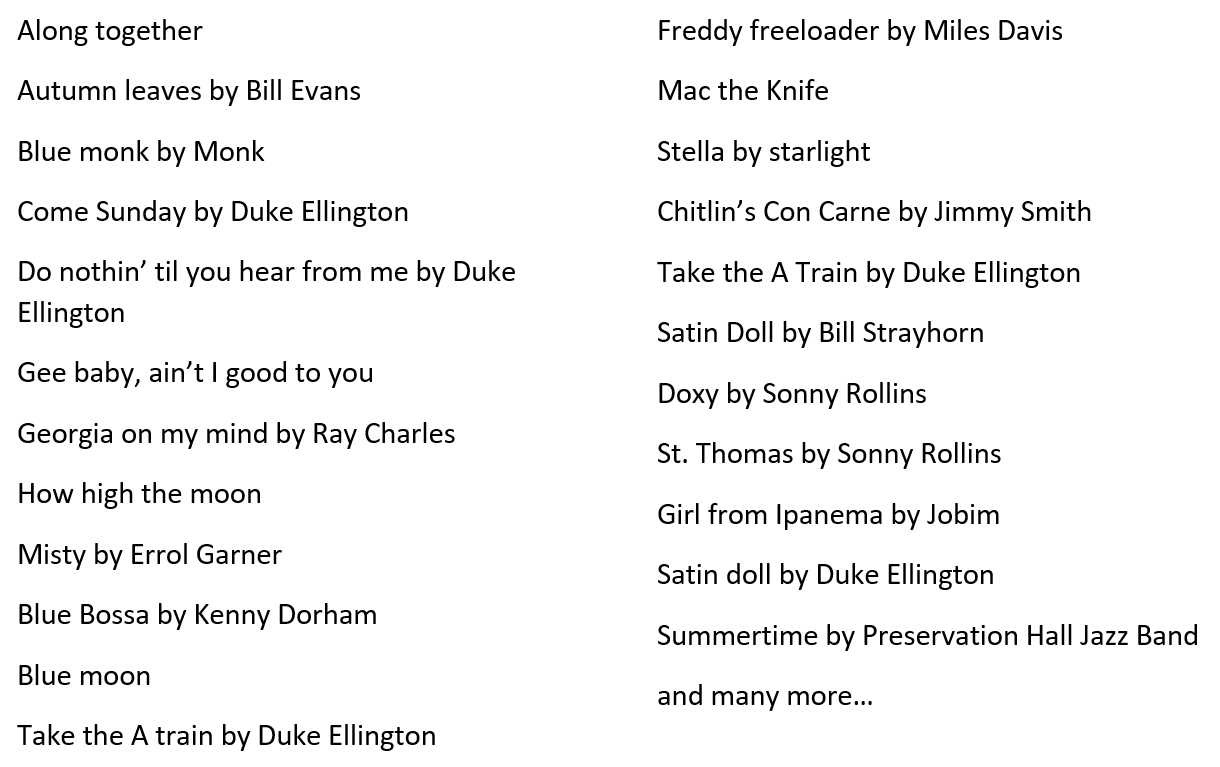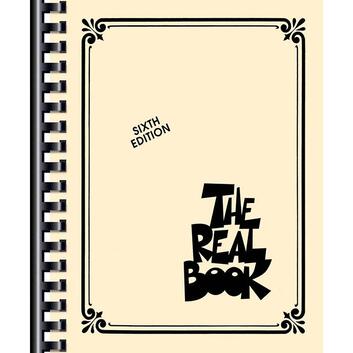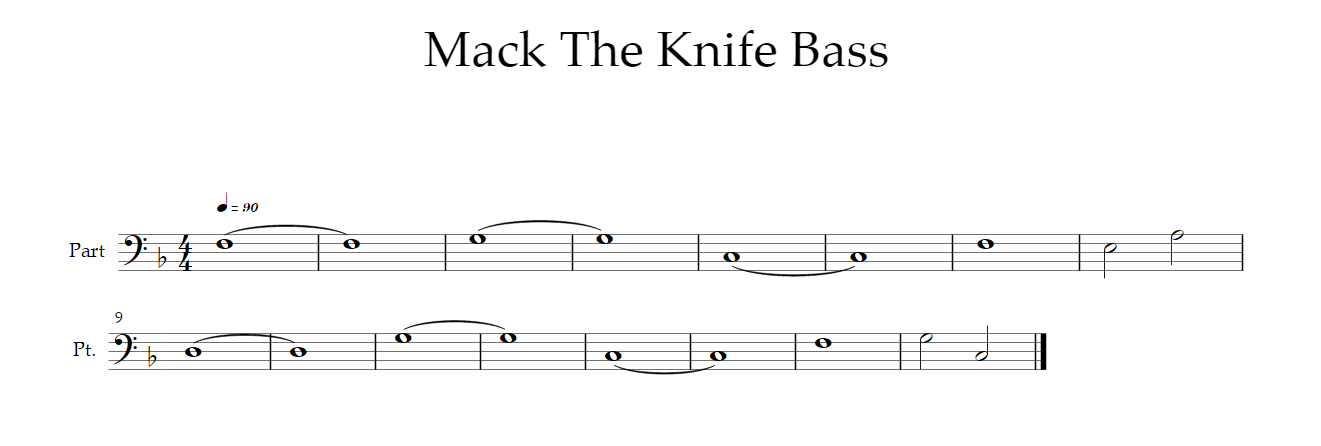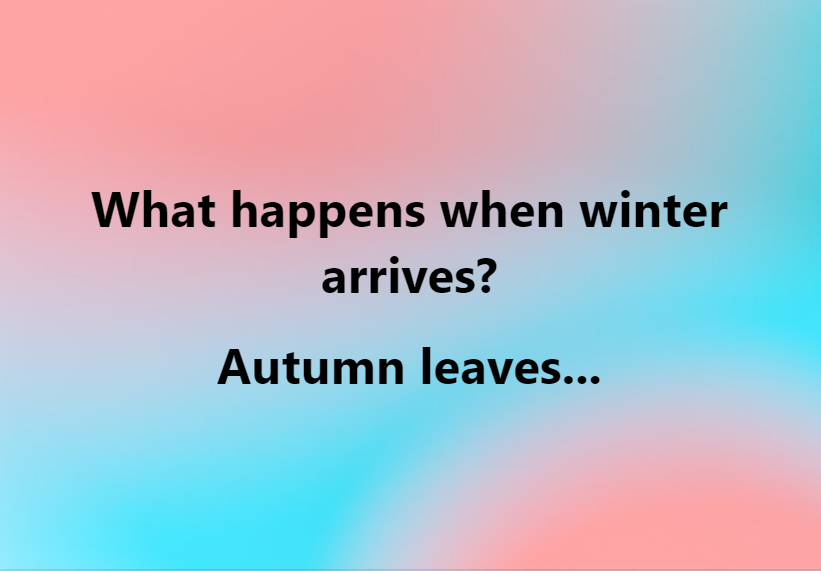I'm the proud teacher of Eric Liang. He is a hard-working musician who is now studying in New York City in 2022-2023.
Jazz Curriculum for Beginners
A partial listing of tunes that students are currently playing
"Go deeper on fewer pieces" Aaron Goldberg, Poland 2018
Tip#1: memorize the tune and chords before you try to improvise. David Story 2022
General Outline of my Jazz Curriculum
Playing jazz requires a solid foundation in different skills. I've broken down the requirements, to play competently, into units. We will work, concurrently, through several of the units. The exact order of events will depend on your personal situation.
Unit 1: Introduction to Jazz Piano
• Brief history of jazz music and jazz piano
• Overview of the elements of jazz music (rhythm, harmony, melody, improvisation)
• Introduction to the 12-bar blues form and licks through studying tunes like C jam blues
Unit 2: Developing Technique
• Hand positioning and finger independence exercises to keep the hands strong and ready to improvise.
• Scales and arpeggios in all keys
• Basic chord voicings (root position, inversions, the 60 jazz 7th chords, Bebop shells)
Unit 3: Rhythm and Time
• Understanding swing feel and syncopation
• Basic rhythmic patterns of jazz (2-feel, 3-feel, 4-feel)
• Using a metronome to develop timing and precision
Unit 4: Harmony and Chord Progressions
• Review of major and minor scales and chord types
• Introduction to diatonic harmony and chord progressions
• Learning and analyzing common jazz chord progressions (ii-V-I, iii-VI-ii-V)
Unit 5: Improvisation
• Introduction to improvisation through messing with the melody. This advice comes from Louis Armstrong. "Learn the tune, mess with the tune, mess with the mess."
• Ear training exercises and transcribing simple melodies by ear
• Basic improvisation techniques (chord tones, scales, approach notes)
Unit 6: Jazz Standards
• Introduction to playing jazz standards
• Learning to read lead sheets and chord symbols from a fakebook
• Applying improvisation techniques to jazz standards
Unit 7: Advanced Chord Voicings
• Introduction to advanced chord voicings (rootless voicings, drop 2, drop 3, quartal voicings)
• Applying advanced chord voicings to jazz standards and chord progressions
Unit 8: Developing Your Own Style
• Finding your own voice as a jazz pianist through exploring jazz history and other genres
• Exploring different styles within the jazz genre (traditional, swing, bebop, modal, fusion, etc.)
• Transcribing and analyzing the playing of your favorite jazz pianists
Unit 9: Ensemble Playing
• Playing with other musicians in a jazz ensemble
• Learning to comp for other soloists
• Playing in a rhythm section and interacting with bass and drums
Unit 10: Performance Preparation
• Preparing for a solo performance or recital
• Choosing repertoire and preparing a set list
• Developing stage presence and overcoming performance anxiety
Unit 1: Introduction to Jazz Piano
• Brief history of jazz music and jazz piano
• Overview of the elements of jazz music (rhythm, harmony, melody, improvisation)
• Introduction to the 12-bar blues form and licks through studying tunes like C jam blues
Unit 2: Developing Technique
• Hand positioning and finger independence exercises to keep the hands strong and ready to improvise.
• Scales and arpeggios in all keys
• Basic chord voicings (root position, inversions, the 60 jazz 7th chords, Bebop shells)
Unit 3: Rhythm and Time
• Understanding swing feel and syncopation
• Basic rhythmic patterns of jazz (2-feel, 3-feel, 4-feel)
• Using a metronome to develop timing and precision
Unit 4: Harmony and Chord Progressions
• Review of major and minor scales and chord types
• Introduction to diatonic harmony and chord progressions
• Learning and analyzing common jazz chord progressions (ii-V-I, iii-VI-ii-V)
Unit 5: Improvisation
• Introduction to improvisation through messing with the melody. This advice comes from Louis Armstrong. "Learn the tune, mess with the tune, mess with the mess."
• Ear training exercises and transcribing simple melodies by ear
• Basic improvisation techniques (chord tones, scales, approach notes)
Unit 6: Jazz Standards
• Introduction to playing jazz standards
• Learning to read lead sheets and chord symbols from a fakebook
• Applying improvisation techniques to jazz standards
Unit 7: Advanced Chord Voicings
• Introduction to advanced chord voicings (rootless voicings, drop 2, drop 3, quartal voicings)
• Applying advanced chord voicings to jazz standards and chord progressions
Unit 8: Developing Your Own Style
• Finding your own voice as a jazz pianist through exploring jazz history and other genres
• Exploring different styles within the jazz genre (traditional, swing, bebop, modal, fusion, etc.)
• Transcribing and analyzing the playing of your favorite jazz pianists
Unit 9: Ensemble Playing
• Playing with other musicians in a jazz ensemble
• Learning to comp for other soloists
• Playing in a rhythm section and interacting with bass and drums
Unit 10: Performance Preparation
• Preparing for a solo performance or recital
• Choosing repertoire and preparing a set list
• Developing stage presence and overcoming performance anxiety
"Sing the bass lines" Aaron Goldberg, Poland 2018
A sample jazz lesson from December 2020
Goal: Memorize and perform Mack the Knife
John is a retired executive with a lifelong interest in jazz and decades of experience playing the piano.
John's first step is to listen to the tune over and over until he knows it as well as happy birthday.
John's second step is figuring out the melody by ear. Then he transposes the melody into various keys. Below are some recordings he started with.
(Bill McBirnie, a jazz flutist of note, plays the melodies along with different recordings. This is a clever idea for practicing as he gets to explore different keys, tempos, and rhythmic feels.)
John then sang the bass line along with Mr. Sonny Bass. It is printed below.
John is a retired executive with a lifelong interest in jazz and decades of experience playing the piano.
John's first step is to listen to the tune over and over until he knows it as well as happy birthday.
John's second step is figuring out the melody by ear. Then he transposes the melody into various keys. Below are some recordings he started with.
- https://youtu.be/cKNUFvETG4I Clarke Terry
- (9) Paul "Tchan Tchou" Vidal - Mack the Knife - Guitar Transcription - YouTube
- https://youtu.be/6vXAtVbZbkI Ella loses the words, a classic version
(Bill McBirnie, a jazz flutist of note, plays the melodies along with different recordings. This is a clever idea for practicing as he gets to explore different keys, tempos, and rhythmic feels.)
John then sang the bass line along with Mr. Sonny Bass. It is printed below.
- Mr. Sonny Bass plays the melody in multiple keys https://youtu.be/wwzTRc0GKZ0 2 keys starting in F https://youtu.be/03mIqhyuSw8 6 keys starting G
John next prepared to improvise by working on the basic building blocks of improvisation technique.
John is now ready.
- Broken chords
- Broken chords with chromatic approach
- Enclosures
- Scales, including the bebop scale on the dominant
- A Blues lick on the ii-V
- Then we took a lick from a transcription found on the Clarke Terry Transcription above.
- The we transposed out simple lick into different keys
John is now ready.
What and how to practice jazz piano as an intermediate pianist
Your overall goal is to work on your time, piano tone, improvisation, and repertoire.
Materials needed:
Materials needed:
- metronome
- audio recording
- play along software
- YouTube
- Fakebook
- Warmup by playing written music. This will preserve the skills you have acquired over the years as jazz piano is notorious for weakening the left hand of classically trained pianists. I usually play Classical piano to keep my hands sharp. You could play fully written jazz arrangements.
- Review your memorized repertoire of blues, ballads, a standard or two, and Bossa Nova tunes. Recording yourself is an excellent way to self-analyze your playing.
- Practice by playing your repertoire along with the great recordings.
- Acquiring simple licks from the recordings and transposing them into the keys of your memorized repertoire.




